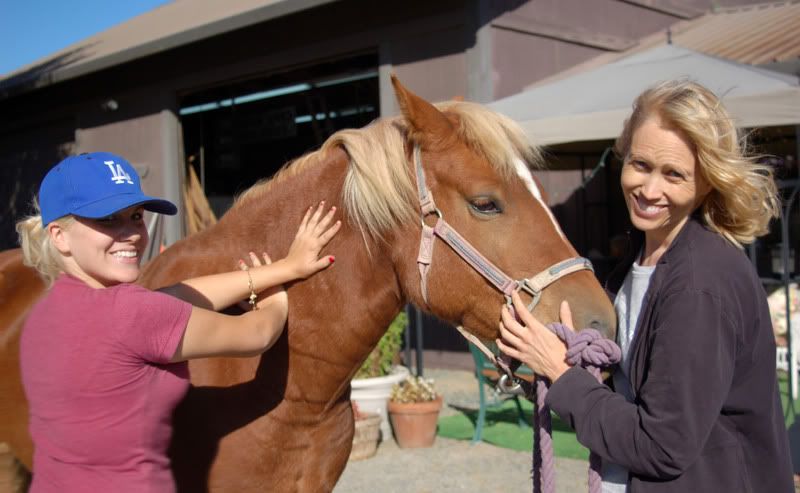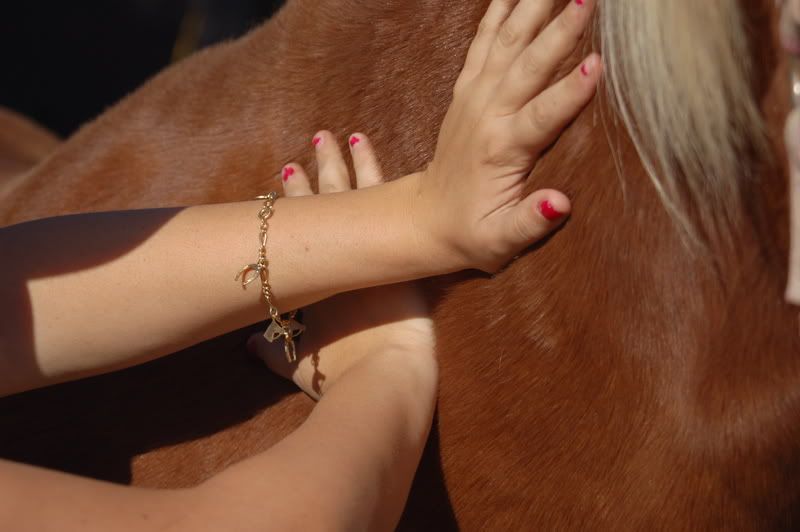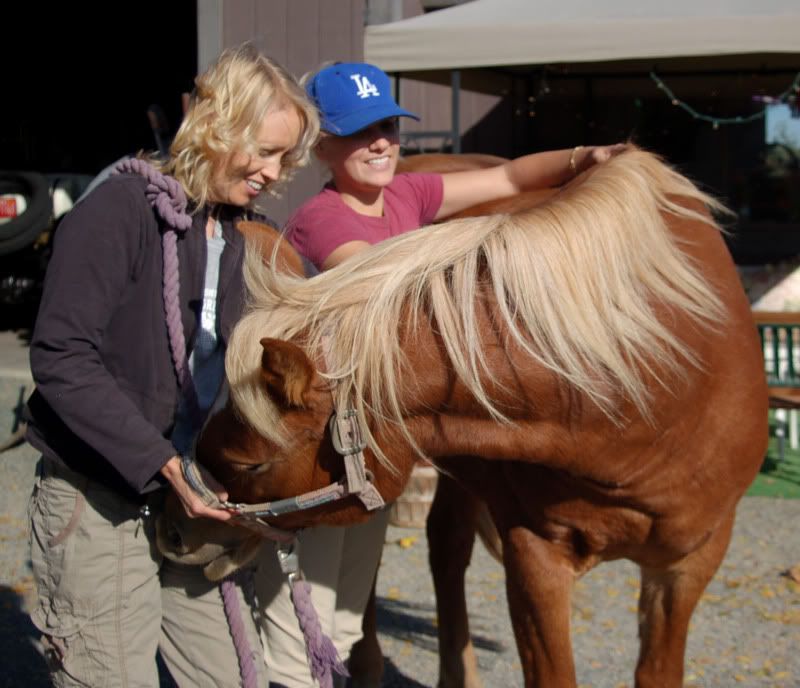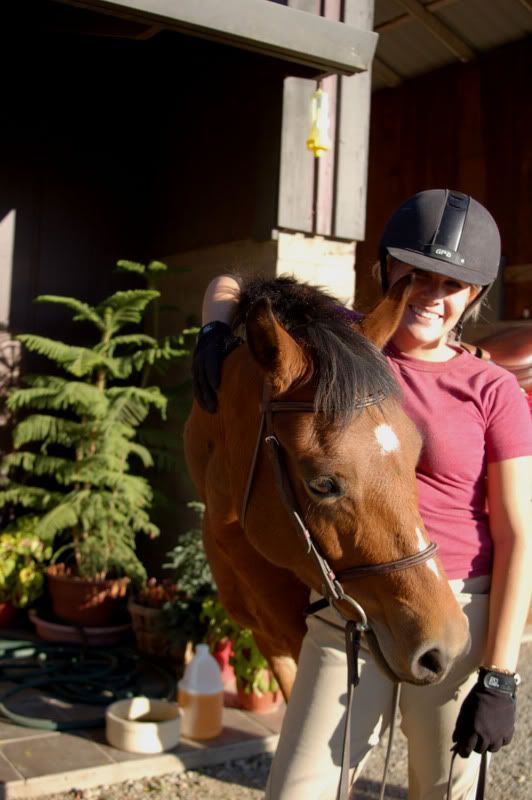27 September, 2008
Everything that is old is new again.
On a more personal note: So after moving from Northern California to Orange County and taking a 9 month break from riding due to an injury, I am finally back in the game. I have a great job at BMW for nights and weekends, and I am teaching and riding again! I love my students and the fantastic horses at the barn I'm currently working for. I'll update with a few details later, just wanted to you to get the gist of it.
25 October, 2007
Add-on to the Myofascial Release Post: Photos

Using a "Cross-stretch" to loosen up Izzy's neck.

A close-up of the cross-stretch.

Bending Izzy's neck to obtain a stretch on one side and to work out any stiffness on the other.
Happy Halloweeeeeen!
Our Whimbrel Farms Halloween Party is coming up this Saturday. Apple bobbing, sack races, carmel apples, games, plenty of food! We're going to get glowsticks for the kids and take them into the "haunted" woods at night time. Ha Ha. Should be loads of fun!
I've been having some phenomenal rides on Flirt, Sophie, Raquel, even Izzy. Flirt has really be doing great with her jumping. She no longer rushes the jumps and I am able to adjust her stride appropriately so she doesn't leave out strides in outside lines. I would like her to be in more of a frame for the Holiday show so I will incorporate that into our rides from now until them.
Sophie has also been doing extremely well. I am getting her used to shoulder-ins, haunches-in, leg yield, etc. She can go through all 3 gaits in a nice frame and is easy to collect and extend. She has sooo much potential. I love her.
Raquel is much more relaxed under saddle but in my opinion needs more work on the trot to canter and walk to canter transition which she tends to rush. Her canter can also be rushed but half-halts really help.
All of the horses need work up and down the hills to build up their hind ends.
Unfortunately a little accident with Izzy left me with a twisted back so I didn't get a chance to do a recovery ride on each of the horses..Tomorrow I should be better. Then it's time to decorate for the party!
I've been having some phenomenal rides on Flirt, Sophie, Raquel, even Izzy. Flirt has really be doing great with her jumping. She no longer rushes the jumps and I am able to adjust her stride appropriately so she doesn't leave out strides in outside lines. I would like her to be in more of a frame for the Holiday show so I will incorporate that into our rides from now until them.
Sophie has also been doing extremely well. I am getting her used to shoulder-ins, haunches-in, leg yield, etc. She can go through all 3 gaits in a nice frame and is easy to collect and extend. She has sooo much potential. I love her.
Raquel is much more relaxed under saddle but in my opinion needs more work on the trot to canter and walk to canter transition which she tends to rush. Her canter can also be rushed but half-halts really help.
All of the horses need work up and down the hills to build up their hind ends.
Unfortunately a little accident with Izzy left me with a twisted back so I didn't get a chance to do a recovery ride on each of the horses..Tomorrow I should be better. Then it's time to decorate for the party!
10 October, 2007
I'm so proud.
I have such great students!
I love watching them grow and learn. They continue to surprise me each day that I work with them. It truly is a joy.
I love watching them grow and learn. They continue to surprise me each day that I work with them. It truly is a joy.
07 October, 2007
Equine Myofascial Release
I have had the extraordinary oppertunity to watch and then experience a technique that is very new to me. It's called Equine Myofascial Release.
It works by elongating forshortened connective tissue, called fascia (Fash-Uh). It covers every muscle, bone, cell, and nerve in the body. When a horse is injured or recieves sustained trauma due to training, the fascial system tightens as a protective response.
These things overtime can cause your horse to become stiff, movement becomes limited, structural alignment may be altered, etc.
With a therapist applying gentle pressure in the affected areas for 90-120 seconds, it serves to elongate this connective tissue and therefore we can receieve a better, and more pain-free, performance and movement from our horses.
I have seen this performed on three of our own horses with amazing results. For example, an older mare went from being stiff (and slightly tense and cranky) at the beginning of the treatment session to an extremely relaxed, freely moving animal.
So how do you know if you horse is a candidate for EMFR?
Any horse can benefit from this type of therapy, although horses with a prior history of lameness or injury are especially good candidates.
To find out more about Equine Myofascial Release, check out this website http://www.somapt.com/equine
It works by elongating forshortened connective tissue, called fascia (Fash-Uh). It covers every muscle, bone, cell, and nerve in the body. When a horse is injured or recieves sustained trauma due to training, the fascial system tightens as a protective response.
These things overtime can cause your horse to become stiff, movement becomes limited, structural alignment may be altered, etc.
With a therapist applying gentle pressure in the affected areas for 90-120 seconds, it serves to elongate this connective tissue and therefore we can receieve a better, and more pain-free, performance and movement from our horses.
I have seen this performed on three of our own horses with amazing results. For example, an older mare went from being stiff (and slightly tense and cranky) at the beginning of the treatment session to an extremely relaxed, freely moving animal.
So how do you know if you horse is a candidate for EMFR?
Any horse can benefit from this type of therapy, although horses with a prior history of lameness or injury are especially good candidates.
To find out more about Equine Myofascial Release, check out this website http://www.somapt.com/equine
05 October, 2007
Things Only Horseback Riders Know
* Believe in the 11th Commandment: Inside leg to outside rein.
* Know that all topical medications come in either indelible blue or neon yellow.
* Think nothing of eating a sandwich after mucking out stables.
* Know why a thermometer has a yard of yarn attached to one end of it.
* Are banned from Laundromats.
* Fail to associate whips, chains and leather with sexual deviancy.
* Can magically lower their voices five octaves to bellow at a pawing horse.
* Have a language all their own ("If he pops his shoulder, I have to close that hand and keep pushing with my seat in case he sucks back".)
* Will end relationships over their hobby.
* Cluck to their cars to help them up hills.
* Insure their horses for more than their cars.
* Will give you 20 names and reasons for that bump on your horse.
* Know more about their horse's nutrition than their own.
* Have neatsfoot oil stains on the carpet right next to the TV.
* Have a vocabulary that can make a sailor blush.
* Have less wardrobe than their horse.
* Engage in a hobby that is more work than their day job.
* Know that mucking stalls is better then Zoloft any day!
* Can smell moldy hay a mile away, but can't tell where the odor in the refrigerator is coming from.
* Know that all topical medications come in either indelible blue or neon yellow.
* Think nothing of eating a sandwich after mucking out stables.
* Know why a thermometer has a yard of yarn attached to one end of it.
* Are banned from Laundromats.
* Fail to associate whips, chains and leather with sexual deviancy.
* Can magically lower their voices five octaves to bellow at a pawing horse.
* Have a language all their own ("If he pops his shoulder, I have to close that hand and keep pushing with my seat in case he sucks back".)
* Will end relationships over their hobby.
* Cluck to their cars to help them up hills.
* Insure their horses for more than their cars.
* Will give you 20 names and reasons for that bump on your horse.
* Know more about their horse's nutrition than their own.
* Have neatsfoot oil stains on the carpet right next to the TV.
* Have a vocabulary that can make a sailor blush.
* Have less wardrobe than their horse.
* Engage in a hobby that is more work than their day job.
* Know that mucking stalls is better then Zoloft any day!
* Can smell moldy hay a mile away, but can't tell where the odor in the refrigerator is coming from.
Winter and Your Horses - What You Can Do
I know its only October, but our area has been getting an early taste of winter this year so I thought I would post some helpful tips on how to keep your horse healthy, warm, and happy all throughout the season.
It's always a good idea to start out by evaluating your horse's living quarters. Does he spend all his time in an open pasture or is he stall-bound? Or, does he have a box stall with a run? A paddock? Etc. A horse in open pasture will need a shelter from both rain and wind.
If your horse is not showing, allow him to develop his thick winter coat by nixing the blankets in the early months of winter. By letting him acclimate to the changing conditions you are keeping your horse more comfortable in the long-run. The problem with blanketing "outdoor" horses is that blankets can slip, causing rubs, sores, and can become damp serving to chill the horse rather than to keep him warm.
It's smart to have someone around here and there to monitor the situation if you do decide to blanket. They can make adjustments, or remove them if the blankets become damp or if the temperature decides to rise.
If you do heavy winter riding, consider a body clip. There are many different kinds of body clip "styles" that are suited to the individual needs of the horse. Any horse that is body clipped will need to be blanketed.
The next step would be to check your feeding system and rations. This depends on the age of your horse, the size, and the workload your horse will be put through in the winter. For example, an adult horse under light work needs about 1 percent of his weight in hay/roughage, and a good grass hay will be sufficient. If needed, you may add a concentrated feed (or grain) to his schedule.
A horse will drink six to ten gallons of water per day. Amazing right? So you must make sure there is a clean source available at all times. This may mean (depending on where you live) chipping the ice out of the water buckets at each feed time. Salt blocks are neccesary year-round, so be sure those are clean and available as well.
Last but not least, don't skimp on hoof care!! Even barefoot horses' feet need to be picked out daily to prevent problems such as thrush, etc. In addition, the hoof wall does not stop growing during the winter, and will need regular balancing to keep its shape. More importantly, the farrier will check for bruises on the soles of the feet caused by hard ground or ice. Many hoof abcesses found in the spring were actually caused by undiagnosed bruises obtained in the winter.
So there you have it, the basics of winter horse care. By following these guidelines you'll be sure to have a safe and healthy horse. So enjoy the holiday season, saddle up, and have a great ride!
It's always a good idea to start out by evaluating your horse's living quarters. Does he spend all his time in an open pasture or is he stall-bound? Or, does he have a box stall with a run? A paddock? Etc. A horse in open pasture will need a shelter from both rain and wind.
If your horse is not showing, allow him to develop his thick winter coat by nixing the blankets in the early months of winter. By letting him acclimate to the changing conditions you are keeping your horse more comfortable in the long-run. The problem with blanketing "outdoor" horses is that blankets can slip, causing rubs, sores, and can become damp serving to chill the horse rather than to keep him warm.
It's smart to have someone around here and there to monitor the situation if you do decide to blanket. They can make adjustments, or remove them if the blankets become damp or if the temperature decides to rise.
If you do heavy winter riding, consider a body clip. There are many different kinds of body clip "styles" that are suited to the individual needs of the horse. Any horse that is body clipped will need to be blanketed.
The next step would be to check your feeding system and rations. This depends on the age of your horse, the size, and the workload your horse will be put through in the winter. For example, an adult horse under light work needs about 1 percent of his weight in hay/roughage, and a good grass hay will be sufficient. If needed, you may add a concentrated feed (or grain) to his schedule.
A horse will drink six to ten gallons of water per day. Amazing right? So you must make sure there is a clean source available at all times. This may mean (depending on where you live) chipping the ice out of the water buckets at each feed time. Salt blocks are neccesary year-round, so be sure those are clean and available as well.
Last but not least, don't skimp on hoof care!! Even barefoot horses' feet need to be picked out daily to prevent problems such as thrush, etc. In addition, the hoof wall does not stop growing during the winter, and will need regular balancing to keep its shape. More importantly, the farrier will check for bruises on the soles of the feet caused by hard ground or ice. Many hoof abcesses found in the spring were actually caused by undiagnosed bruises obtained in the winter.
So there you have it, the basics of winter horse care. By following these guidelines you'll be sure to have a safe and healthy horse. So enjoy the holiday season, saddle up, and have a great ride!
Subscribe to:
Posts (Atom)



